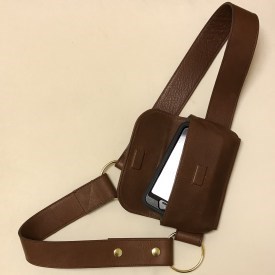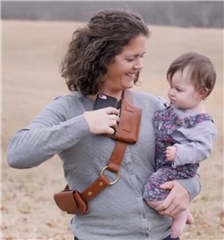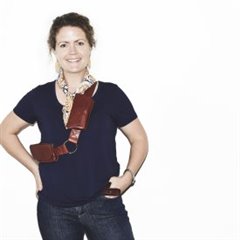For many people, handbags, backpacks, or messenger bags are the go to option for light, simple storage. The U.S. handbag market alone brought in $11.6 billion dollars in 2015, according to a report from market research company NPD Group, Inc. Margaret Murray Bloom, however, is not one of those people.
“The origin of the Murray Belt is from a real pain point of mine, which was that I never had pants that had pockets big enough to hold my phone, wallet, and keys. A purse or something similar is an inconvenience for me -- I work on a farm, and can’t carry a bag with me everywhere I go. So, I wanted a way to carry my essentials and also get rid of the decision fatigue that comes with constantly managing those essentials.”
 Margaret’s Murray Belt combines the stylistic qualities of a bandolier belt and the convenience of a handbag into an attractive, low form factor over-the-shoulder belt that sits tight against the torso, accompanying you from music festivals to rock climbing, from dinner parties to a late night walk. But Margaret isn’t only concerned with convenience -- she also wants to promote a certain kind of lifestyle and engagement with the world through her Murray Belt. “I’ve always been really big on fully engaging in my experiences. I’m pretty adventuresome; I like to travel, I like to get to know people and listen to their stories. But nowadays, it’s a necessity to have our phones with us so that we can digitally capture memories. So I’ve embraced it and said to myself, ‘If I need to have my phone with me, then I’ll have my phone with me, but I’m not going to let it distract me.’”
Margaret’s Murray Belt combines the stylistic qualities of a bandolier belt and the convenience of a handbag into an attractive, low form factor over-the-shoulder belt that sits tight against the torso, accompanying you from music festivals to rock climbing, from dinner parties to a late night walk. But Margaret isn’t only concerned with convenience -- she also wants to promote a certain kind of lifestyle and engagement with the world through her Murray Belt. “I’ve always been really big on fully engaging in my experiences. I’m pretty adventuresome; I like to travel, I like to get to know people and listen to their stories. But nowadays, it’s a necessity to have our phones with us so that we can digitally capture memories. So I’ve embraced it and said to myself, ‘If I need to have my phone with me, then I’ll have my phone with me, but I’m not going to let it distract me.’”
***
It is still debated whether or not phones, computers, or the Internet itself can be “addictive”, or at least create addictive habits stemming from the Internet. While research on this phenomenon is ongoing, there is no denying that in the span of a few decades, the Internet has because very pervasive in modern society, and many people question whether overexposure to technology results in any adverse effects on the mind. For her part, Margaret is just hoping to impart the importance of reducing the “touch points”, or the number of times a day you physically interact with your phone, as much as is feasibly possible. “I want to free people from worrying about where they put their stuff or missing out on experiences because they didn’t have somewhere to put their things. I hope to empower my customers to engage with their experiences, not their possessions,” Margaret says firmly.

To continue to develop her Murray Belt, Margaret is looking to procure at least two more team members to help work on the Murray Belt alongside her. “It would be great to bring on new members sooner rather than later, because I see from the other iLab teams that there is immense strength in numbers and it’s really important to have multiple points of view in the early stages of your venture,” Margaret says.
As for how she plans to reshape the personal accessory market, Margaret hopes one day to “have the Murray Belt be as identifiable as a fanny pack. So if I showed you a silhouette of a person with a belt across their body, you’d go, ‘Yeah, that’s a Murray Belt.’” And to go along with her Murray Belt, Margaret wants to send a message:
“Somebody who wears a Murray Belt is someone who is ready for adventure and new experiences, and wants to be mobile, free, and not tied down to anything.”
***
 About The Founder
About The Founder
Margaret Murray Bloom graduated from Mary Washington University in 2007. At home, she works on her family farm and manages weddings during the summer and early fall, hosting events through her business, Panorama Events. Her product, the Murray Belt, can be purchased at https://murraybcompany.com. More photos and posts featuring the Murray Belt can be found on Twitter, Facebook, and Instagram. Margaret can be contacted through the Murray B. Company website, info@murraybcompany.com, or at margaret@murraybcompany.com.

-

Melissa Stefaniak
-
Cancel
-
Vote Up
0
Vote Down
-
-
Sign in to reply
-
More
-
Cancel
Comment-

Melissa Stefaniak
-
Cancel
-
Vote Up
0
Vote Down
-
-
Sign in to reply
-
More
-
Cancel
Children